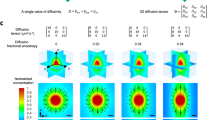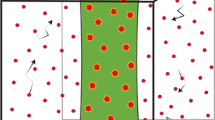Abstract
Fluorescence recovery after photobleaching (FRAP) has been widely used to measure fluid flow and diffusion in gels and tissues. It has not been widely used in detection of tissue anisotropy. This may be due to a lack of applicable theory, or due to inherent limitations of the method. We discuss theoretical aspects of the relationship between anisotropy of tissue structure and anisotropy of diffusion coefficients, with special regard to the size of the tracer molecule used. We derive a semi-mechanistic formula relating the fiber volume fraction and ratio of fiber and tracer molecule diameters to the expected anisotropy of the diffusion coefficients. This formula and others are tested on simulated random walks through random simulated and natural media. We determine bounds on the applicability of FRAP for detection of tissue anisotropy, and suggest minimum tracer sizes for detection of anisotropy in tissues of different composition (fiber volume fraction and fiber diameter). We find that it will be easier to detect anisotropy in monodisperse materials than in polydisperse materials. To detect mild anisotropy in a tissue, such as cartilage, which has a low fiber fraction would require a tracer molecule so large that it would be difficult to deliver to the tissue. We conclude that FRAP can be used to detect tissue anisotropy when the tracer molecule is sufficiently large relative to the fiber diameter, volume fraction, and degree of polydispersivity, and when the anisotropy is sufficiently pronounced.
Similar content being viewed by others
References
Axelrod, D., Koppel, D.E., Schlessinger, J., Elson, E., Webb, W.W., 1976. Mobility measurement by analysis of fluorescence photobleaching recovery kinetics. Biophys. J. 16, 1055–1069.
Beun, S., Chaturvedi, P., Gebauer, B., Latulippe, J., Zhao, M., Guilak, F., Haider, M., 2003. Mathematical models for articular cartilage. In Gremaud, P.A., Li, Z., Smith, R.C., Tran, H.T. (Eds.), Industrial Mathematics Modeling Workshop for Graduate Students, July 22–July 30, 2002. CRSC Technical Report TR03-37, http://www.ncsu.edu/crsc/reports/reports03.htm.
Chiew, Y.C., Glandt, E.D., 1984. Interfacial surface area in dispersions and porous media. J. Colloid Interf. Sci. 99(1), 86–97.
Clague, D.S., Phillips, R.J., 1996. Hindered diffusion of spherical macromolecules through dilute fibrous media. Phys. Fluids 8(7), 1720–1731.
Cooper, D.W., 1988. Random sequential packing simulations in 3D for spheres. Phys. Rev. A 38, 522–524.
Ekani-Nkodo, A., Fygenson, D.K., 2003. Size exclusion and diffusion of fluoresceinated probes within collagen fibrils. Phys. Rev. E 67.
Gennerich, A., Schild, D., 2002. Anisotropic diffusion in mitral cell dendrites revealed by fluorescence correlation spectroscopy. Biophys. J. 83, 510–522
Han, S., Gemmell, S.J., Helmer, K.G., Grigg, P., Wellen, J.W., Hoffman, A.H., Sotak, C.H., 2000. Changes in ADC caused by tensile loading of rabbit Achilles tendon: Evidence for water transport. J. Magn. Reson. 144, 217–227.
Han, J., Herzfeld, J., 1993. Macromolecular diffusion in crowded solutions. Biophys. J. 65, 1155–1161.
Hsu, E.W., Setton, L.A., 1999. Diffusion tensor microscopy of the intervertebral disc anulus fibrosus. Magn. Reson. Med. 41, 992–999.
Jacobson, K., 2000. Fluorescence microscopy. Encyclopedia of Life Sciences, Nature Publishing Group, http://www.els.net/.
Jeffery, A.K., Blunn, G.W., Archer, C.W., Bentley, G., 1991. 3-Dimensional collagen architecture in bovine articular cartilage. J. Bone Joint Surg. Br. 73(5), 795–801.
Kansal, A.R., Torquato, S., Harsh I.V., G.R., Chiocca, E.A., Deisboeck, T.S., 2000. Cellular automation of idealized brain tumor growth dynamics. Biosystems 55: 119–127.
Kinsey, S.T., Locke, B.R., Penke, B., Moerland, T.S., 1999. Diffusional anisotropy is induced by subcellular barriers in skeletal muscle. NMR Biomed. 12, 1–7.
Leddy, H.A., Guilak, F., 2003. Site-specific molecular diffusion in articular cartilage measured using fluorescence recovery after photobleaching. Ann. Biomed. Eng. 31, 753–760.
Lee, S.B., Torquato, S., 1988. Porosity for the penetrable-concentric-shell model of two-phase disordered media: Computer simulation results. J. Chem. Phys. 89(5), 3258–3263.
Meyvis, T.K.L., de Smedt, S.C., van Oostveldt, P., Demeester, J., 1999. Fluorescence recovery after photobleaching: a versatile tool for mobility and interaction measurements in pharmaceutical research. Pharm. Res. 16(8), 1153–1162.
Patel, R.B., O'Leary, J.M., Vasanja, A., Knothe Tate, M.L., 2005. Determining the permeability of cortical bone at multiple length scales using fluorescence recovery after photobleaching techniques. Transactions of the 51st Annual Meeting of the Orthopaedic Research Society, vol. 30 #0141
Pluen, A., Netti, P.A., Jain, R.K., Berk, D.A., 1999. Diffusion of macromolecules in agarose gels: comparison of linear and globular configurations. Biophys. J. 77, 542–552.
Rikvold, P.A., Stell, G., 1985. D-dimensional interpenetrable-sphere models of random two-phase media: Microstructure and an application to chromatography. J Colloid Interf. Sci. 108, 158.
Strocchi, R., De Pasquale, V., Facchini, A., Raspanti, M., Zaffagnini, S., Marcacci, M., 1996. Age-related changes in human anterior cruciate ligament (ACL) collagen fibrils. It. J. Anat. Embryol. 101(4), 213–220.
Torquato, S., 2002. Random Heterogeneous Materials: Microstructure and Macroscopic Properties. Springer, New York.
Torquato, S., Stell, G., 1984. Microstructure of two-phase random media. IV. Expected surface area of a dispersion of penetrable spheres and its characteristic function. J. Chem. Phys. 80(2), 878–880.
Tsay, T., Jacobson, K.A., 1991. Spatial fourier analysis of video photobleaching measurements, principles and optimization. Biophys. J. 60, 360–368.
Watanabe, T., Honda, Y., Fujii, Y., Koyama, M., Tanaka, R., 2004. Serial evaluation of axonal function in patients with brain death by using anisotropic diffusion-weighted magnetic resonance imaging. J. Neurosurg. 100(1), 56–60.
Author information
Authors and Affiliations
Corresponding author
Rights and permissions
About this article
Cite this article
Lubkin, S.R., Wan, X. Optimizing Detection of Tissue Anisotropy by Fluorescence Recovery after Photobleaching. Bull. Math. Biol. 68, 1873–1891 (2006). https://doi.org/10.1007/s11538-006-9074-z
Received:
Accepted:
Published:
Issue Date:
DOI: https://doi.org/10.1007/s11538-006-9074-z




